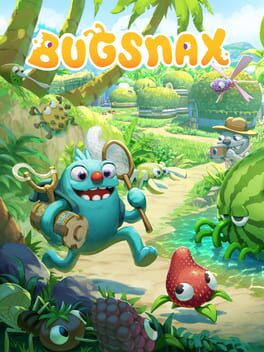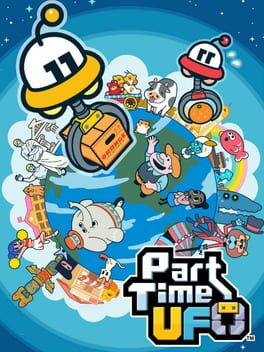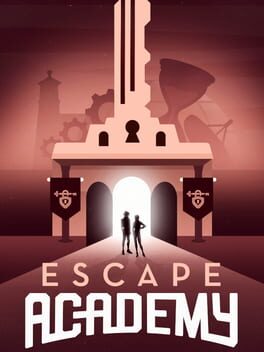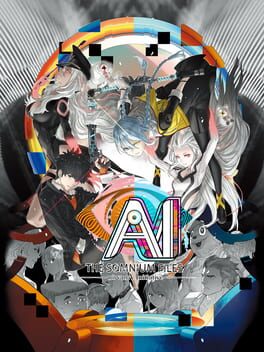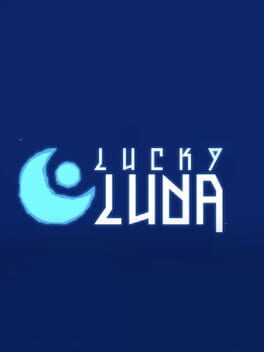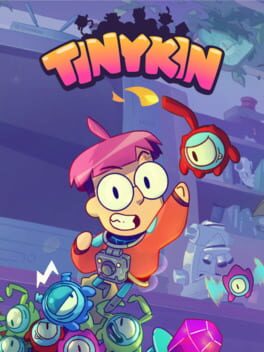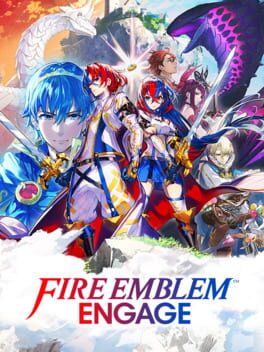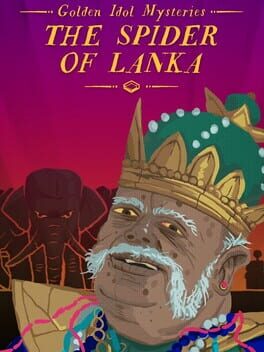scoons
Horizon Forbidden West is at the top of its class for the more "traditional" style of open-world games featuring quest-markers aplenty and oodles of side activities. From the jump the game is downright gorgeous and its narrative is compelling (if not as revelatory as its predecessor). What a joy to play in a sprawling open world where the moment-to-moment combat is the absolute highlight of the experience. Endgame weapon/armor upgrades are way too grindy for my tastes but fortunately not necessary to complete the game.
2004
Pretty barebones, but the fundamental mechanics of Polarium are solid enough. Polarium features 100 line-tracing puzzles and an endless "challenge mode" that's kind of a dud. The soundtrack is literally just the same three synthy notes repeating forever and ever, so probably turn the volume down. Ultimately the game could have used more puzzles and a more robust hint system, but I generally enjoyed working through the available puzzles.
If you like Polarium, try: The Witness
If you like Polarium, try: The Witness
2019
Simogo makes such cool experimental games. Sayonara Wild Hearts’ obvious highlight is its synthy pop soundtrack, which I’ve got on constant repeat when I’m not just playing the game. Chasing high scores is fun, but I’m really here for the stellar music, neon visuals and sparse but affecting narrative. I recommend playing with a controller if you have the opportunity, as I found the touch controls on mobile a bit imprecise.
If you like Sayonara Wild Hearts, play Simogo’s other best game (narrative experience?), Device 6 on iOS!
If you like Sayonara Wild Hearts, play Simogo’s other best game (narrative experience?), Device 6 on iOS!
2020
Fruit flavored body horror for all ages. Or something. I can't say Bugsnax is a ton of fun to actually play, but the characters are colorful, literally and figuratively, and the mystery of the Snacktooth Island is compelling, for a while at least. The simple pokémon of it all wears thin pretty quickly with some truly cumbersome critter catching mechanics, but the surprisingly deep narrative kept me hooked til the last wriggling bite.
2022
Tunic is a mix of Zelda and Fez, weighted just a little too heavily on the Zelda side of things. Tunic is at its best when you're making mind-bending discoveries that flip your understanding of the world on its head. Unfortunately the game is a bit too stingy with these revelations, making you wade through a just ok action adventure game and really only revealing its best bits in the puzzle-heavy endgame. That said, the puzzly stuff is super worth experiencing and really scratches a particular itch.
2017
2022
Solid escape room mechanics that always felt fair and intuitive. Not too taxing, but enough to make you feel clever when you work it out. The art direction is nice, especially the 2D character drawings. The character models themselves though... not great. Escape Academy is short and sweet, but could have benefited from some sort of post-game puzzles, as there is little reason to return to puzzles you've already completed.
AI: The Somnium Files - Nirvana Initiative is a great sequel to the original, improving on its primary flaws (incoherent puzzle design and Date) and focusing on its strengths (big twists and Mizuki). Ryuki is also fun as the other new protagonist. I'm a little conflicted on the main twist in this game's story, it's a little too unwieldy to immediately grasp all its implications, but I found myself saying "aha!" again and again over the next few days when I wasn't even playing the game. Pretty cool. Looking forward to the next one, hopefully with an even goofier title.
2022
A unique platformer that unfortunately demands a level of precision from the player that the game can't quite match. One particular challenge near the end of the game had me nearly pulling my hair out, requiring absurdly precise movements to maneuver a series of floating platforms through crushers whose great speed far outpaced my patience. Precision platformers and touch controls just seem like a tough combination, maybe that's why I can't play Celeste on my phone. Additionally, many of the game's secrets seem to require the player to make blind leaps of faith that reward the player with either gems (yay!) or instant death (boo). Things I did like: evocative (though sparse) bits of storytelling, deeply satisfying plinks and plonks when collecting gems, some fun challenges (the ones that didn't make me want to drop my phone into the sewer).
2022
Pikmin stresses me out. Big monsters are always eating my little guys. The clock is ticking down. I accidentally throw my blue guys in the fire and my red guys in the water. Their ghosts taunt me as they float away up to Pikmin heaven.
Tinykin gets rid of all that. It's a relaxing, super chill adventure through a big house with hundreds of my best, most colorful friends. The movement is snappy and satisfying. The art style is beautiful. The writing is consistently charming.
In a perfect world the challenges would be slightly more varied from level to level, expanding in complexity as the game goes on, and there would be a couple more Tinykin types (or potentially more uses for the existing Tinykin). As it stands most of the Tinykin act as simple keys for different colored locks, requiring basically no thought to use. Need to power on that toaster? You can bet there's an outlet nearby. Need to get those Tinykin down from that ledge? I can guarantee you there's a pre-determined ramp building spot just down below. You don't even need to select which color to throw, the game just contextually chucks the appropriate little guy.
I'd love to see a slightly more puzzle-centric sequel in which the problems the player solves ramp up in complexity. Give the player a little more agency to create their own solutions with the tools provided.
All that said, I really enjoyed my time with Tinykin. The existing mechanics sustain the game's brief runtime, and I'd be more than excited to return for a sequel one day.
Tinykin gets rid of all that. It's a relaxing, super chill adventure through a big house with hundreds of my best, most colorful friends. The movement is snappy and satisfying. The art style is beautiful. The writing is consistently charming.
In a perfect world the challenges would be slightly more varied from level to level, expanding in complexity as the game goes on, and there would be a couple more Tinykin types (or potentially more uses for the existing Tinykin). As it stands most of the Tinykin act as simple keys for different colored locks, requiring basically no thought to use. Need to power on that toaster? You can bet there's an outlet nearby. Need to get those Tinykin down from that ledge? I can guarantee you there's a pre-determined ramp building spot just down below. You don't even need to select which color to throw, the game just contextually chucks the appropriate little guy.
I'd love to see a slightly more puzzle-centric sequel in which the problems the player solves ramp up in complexity. Give the player a little more agency to create their own solutions with the tools provided.
All that said, I really enjoyed my time with Tinykin. The existing mechanics sustain the game's brief runtime, and I'd be more than excited to return for a sequel one day.
2022
I think this is a me problem and not a game problem, but I didn't find Iron Lung as unnerving as most folks seem to (and I'm usually kind of a baby when it comes to spooky games). I think I just expected the tension to ramp up more quickly, so most of the game felt tedious as opposed to unsettling. The setting and small bits of lore are super evocative though.
2022
Pentiment is a supremely human tale. What at first seems like a simple murder mystery reveals itself to be something altogether more interesting when you're forced to bring your half-baked accusations before the tribunal well before you’ve gathered all the facts. But time waits for no man, and if it means saving your friend you'll just have to point the finger at... well, someone. Time's up. Heads must roll. And they do.
Pentiment is a game about making peace with the past and sense of the present in a changing world. You have to come to terms with both the choices you've made as the player and the tragic facts of Andreas's life that are simply out of your control. Your impact on this community for good or ill is measured not in days or weeks, but in decades. Time marches on, old resentments linger and new bonds are forged, and through it all you wonder what might have happened if things had gone differently.
There's a quiet melancholy to Pentiment as the seasons change and years pass. The only soundtrack to your days in Tassing are the scritch scratches of quills on parchment. Speaking of which, I absolutely love how obsessed Pentiment is with FONTS. I nearly started the game with the easy read fonts, but I'm so glad I stuck with the stylized option. The fonts as much as anything tell the story of this community, providing texture and even voice to its inhabitants.
One minor mechanical note: The game occasionally presents you with persuasion checks, tallying up all the ways your previous actions have made a character more (or less) willing to heed your sage advice. I failed nearly every check the game offered, sometimes with little explanation, leading me to wonder if I was missing some important and opaque aspect of the game. After some googling I learned that nope, everything was working as intended. Whether this is some kind of reflection of the fact that the characters each bring their own interiority to situations and aren't easily swayed by this outsider, or just a quirk of my impressively uncharismatic protagonist, I don't know, but I definitely found it occasionally frustrating and disappointing.
Pentiment can feel slow in its pacing, especially if you're the kind of person who presses every witness statement in an Ace Attorney game just to make sure you don't miss a single line of dialogue. But the tapestry presented is rich, full of well-realized characters, and replete with fun twists and occasional moments of deep beauty. It’s a journey well worth taking. Especially if you like fonts.
Pentiment is a game about making peace with the past and sense of the present in a changing world. You have to come to terms with both the choices you've made as the player and the tragic facts of Andreas's life that are simply out of your control. Your impact on this community for good or ill is measured not in days or weeks, but in decades. Time marches on, old resentments linger and new bonds are forged, and through it all you wonder what might have happened if things had gone differently.
There's a quiet melancholy to Pentiment as the seasons change and years pass. The only soundtrack to your days in Tassing are the scritch scratches of quills on parchment. Speaking of which, I absolutely love how obsessed Pentiment is with FONTS. I nearly started the game with the easy read fonts, but I'm so glad I stuck with the stylized option. The fonts as much as anything tell the story of this community, providing texture and even voice to its inhabitants.
One minor mechanical note: The game occasionally presents you with persuasion checks, tallying up all the ways your previous actions have made a character more (or less) willing to heed your sage advice. I failed nearly every check the game offered, sometimes with little explanation, leading me to wonder if I was missing some important and opaque aspect of the game. After some googling I learned that nope, everything was working as intended. Whether this is some kind of reflection of the fact that the characters each bring their own interiority to situations and aren't easily swayed by this outsider, or just a quirk of my impressively uncharismatic protagonist, I don't know, but I definitely found it occasionally frustrating and disappointing.
Pentiment can feel slow in its pacing, especially if you're the kind of person who presses every witness statement in an Ace Attorney game just to make sure you don't miss a single line of dialogue. But the tapestry presented is rich, full of well-realized characters, and replete with fun twists and occasional moments of deep beauty. It’s a journey well worth taking. Especially if you like fonts.
2022
This review contains spoilers
Maybe I’m broken inside, but I just don’t get tired of all the wall-climbing and crack-shimmying in modern AAA games. I remember the early days of 3D gaming when everyone’s hands were fingerless rectangles and characters just kind of just drifted up ladders, rungs be damned. So there’s still something magical to me about watching Kratos carefully choose realistic handholds as he clambers up his 48th rock wall. Give me all the walls.
The rest of the game is good too.
Ragnarok trades some of the intimacy of God of War (2018) for grander scale and scope. Everything is more in Ragnarok. More characters, more bosses, more weapons, more ways to slice and dice more enemies. The game occasionally slows down for Kratos and co. to talk about feelings (often while scaling those aforementioned walls), but you always know there’s a big interdimensional lizard to chop up just around the next bend. It helps that the character writing and performances are as sharp as ever. I’ve gotta give a special shoutout to my man Toby and his great walk-and-talks. Richard Schiff is phenomenal as Odin, with a magnetism and seeming vulnerability that almost endears you to him. Almost.
Odin’s machinations come to a head during a late-game twist resulting in Brok’s sudden death. As surprising as this moment was, what was all the more astounding was how Ragnarok absolutely refuses to let the player off this hook, and in doing so hammers home its primary theme. Brok is dead. There’s no post-game quest to undo what happened. There’s no fixing Atreus and Sindri’s shattered friendship. There is no moment of emotional catharsis. Brok is just dead. Ragnarok dares to let some things stay broken, and in doing so infuses everything that follows with a pervasive sense of melancholy. We can’t undo the past. We can only try to be better.
Having replayed God of War 2018 immediately prior to Ragnarok's release, it's astounding the ways the team at SSM was able to refine and expand the original's already stellar combat. Greater enemy variety, more interesting combat arenas, and a vastly expanded moveset mean you can truly express your unique inner rage god as you tear weird little frog guys limb from limb. Things don’t fare quite as well during Atreus’s interludes, but thankfully Kratos still takes center stage.
One stray thought: The Crater is a late-game optional area and absolutely one of the best parts of Ragnarok. It’s an absolutely massive area that manages to weave a compelling narrative that works on its own while still complimenting the main plot. It stands toe-to-toe with the Lake of the Nine from God of War (2018), and hopefully it’s a blueprint for where the series might go next.
The rest of the game is good too.
Ragnarok trades some of the intimacy of God of War (2018) for grander scale and scope. Everything is more in Ragnarok. More characters, more bosses, more weapons, more ways to slice and dice more enemies. The game occasionally slows down for Kratos and co. to talk about feelings (often while scaling those aforementioned walls), but you always know there’s a big interdimensional lizard to chop up just around the next bend. It helps that the character writing and performances are as sharp as ever. I’ve gotta give a special shoutout to my man Toby and his great walk-and-talks. Richard Schiff is phenomenal as Odin, with a magnetism and seeming vulnerability that almost endears you to him. Almost.
Odin’s machinations come to a head during a late-game twist resulting in Brok’s sudden death. As surprising as this moment was, what was all the more astounding was how Ragnarok absolutely refuses to let the player off this hook, and in doing so hammers home its primary theme. Brok is dead. There’s no post-game quest to undo what happened. There’s no fixing Atreus and Sindri’s shattered friendship. There is no moment of emotional catharsis. Brok is just dead. Ragnarok dares to let some things stay broken, and in doing so infuses everything that follows with a pervasive sense of melancholy. We can’t undo the past. We can only try to be better.
Having replayed God of War 2018 immediately prior to Ragnarok's release, it's astounding the ways the team at SSM was able to refine and expand the original's already stellar combat. Greater enemy variety, more interesting combat arenas, and a vastly expanded moveset mean you can truly express your unique inner rage god as you tear weird little frog guys limb from limb. Things don’t fare quite as well during Atreus’s interludes, but thankfully Kratos still takes center stage.
One stray thought: The Crater is a late-game optional area and absolutely one of the best parts of Ragnarok. It’s an absolutely massive area that manages to weave a compelling narrative that works on its own while still complimenting the main plot. It stands toe-to-toe with the Lake of the Nine from God of War (2018), and hopefully it’s a blueprint for where the series might go next.
2023
Fire Emblem Engage trades Three Houses’ operatic tale of fractured kingdoms for something altogether simpler. Alear is a good dragon. She and her friends have to go fight a bad dragon. Also she’s got some crazy looking hair. That’s pretty much it.
So yeah, the character work and worldbuilding isn’t... great. But I've got a soft spot for some goofy anime earnestness, and Engage eventually managed to win me over once I recalibrated my expectations. This is a story that wears its heart right there on its sleeve. Also, after staring at Byleth’s cold dead face for 170 odd hours, what a joy it is to have a protagonist that thinks and talks and has emotions. Alear isn’t an especially deep character by any stretch, but even a little overt characterization goes a long way.
But Engage’s true raison d'etre is the gameplay. The new break system. The absurdly powerful engage rings. The finely tuned difficulty. Unique maps and objectives. Paralogues that celebrate the series’ history. Stunning combat and critical hit animations. Gosh, the animations. For so long the GBA games were the gold standard for Fire Emblem combat animations. Engage might finally give them a run for their money. I will never get tired of Yunaka flitting through the air like some kind of hummingbird ninja to end some poor guy’s life.
Simply put, I’ve never had more fun playing a Fire Emblem game. Engage throws so many powerful tools at you, and then it builds challenges that push you to your limits. For the first time in the series, Engage feels like it was actually balanced around the turn rewind mechanic. In Three Houses the Divine Pulse all but removed the need for planning or strategy. Here, it's an essential tool in your arsenal as you face down overwhelming odds. I lost track of how many times Engage backed me into a seemingly hopeless corner, only for me to narrowly snatch victory from the jaws of defeat. One particular battle featured no fewer than 6 bosses bearing down on my beleaguered army. I remember desperately stalling a pair of powerful enemies on one front while the rest of my army tried—and nearly failed—to take down the nigh-unkillable Mauvier. Dude’s a tank. Overcoming the odds was tense and thrilling, requiring me to take advantage of every tool at my disposal.
Of course not all is perfect in Elyos.
For one, I miss the master classes from Three Houses. It’s a small thing, but they were an exciting late-game goal, giving you something to strive for in the back half of the game, and the extravagant battle outfits were kind of their own reward. It’s a little less fun using a master seal a third of the way into the game and knowing that’s it for that character class-wise.
Absent master classes, Engage’s new skill system steps in to let you customize and power up your units in the late game, with somewhat mixed results. Skills feel appropriately powerful and valuable. Even the less exciting skills that offer a passive stat boost can feel great, turning Yunaka into an unhittable crit-machine or enabling Alcryst to strike even the most distant foes with perfect accuracy.
That said, the skill system has its flaws. For starters, acquiring skills is weirdly tedious. You’ve got to collect bond fragments from the achievement board so you can spend them in the arena to boost emblem levels so you can purchase skills over in the ring chamber, which you can finally equip in the inventory menu, all requiring multiple loading screens as you flit back and forth between various rooms of the Somniel. And at no point in this process will you ever have access to all the information you might find useful, meaning you’ll probably even make duplicate visits to each room if you’ve got the memory of a goldfish like me.
To make matters worse, the cost of the skills makes the entire system unnecessarily restrictive with basically no room for experimentation. SP costs for individual skills feel astronomically high, and with no way to refund SP once you purchase a skill you’d better be dang sure of your character build before investing. This led to me waiting until very late in the game before I really dove into the skill system. A number of the skills are so expensive that they're actually impossible to purchase in the course of a normal run even after playing all main quests and paralogues. [The solution here seems to be taking advantage of the relay trial side activity which can award scrolls that confer SP to your characters. I didn’t mess with relay trials until after completing the game, but I guess it’s there if you want it.]
To play armchair game designer for a sec: I know there’s a careful balancing act at play here, but given that you’re already limited to two inherited skills at any given time, I think Engage would benefit from significantly lowering the skill costs and letting you mix and match depending on your current build or the demands of the map at hand. Heck, maybe you could just automatically inherit skills as you level up your bond with the emblems, rather than waiting until the mid- to late-game to spend your coveted SP on a measly one or two skills (and likely not even the highest level of those skills). This would allow you to mix and match the weaker skills even in the early game, and provide a far greater range of customization. Maybe you’d need to adjust the cost to train up bond levels if this were the case? I don’t know. Just something feels off and I wish it felt a little better.
The gold and ore economy feels similarly unbalanced. I stocked my barnyard fit to bursting with ore hounds, and I still don’t think I received enough silver ore over the course of the entire game to fully upgrade a single endgame weapon. Not to mention that doing so would have cost a full quarter of my gold reserves. The game lets you boost your ore gathering capabilities through charitable donations to each of the game’s four regions, but even the cost of these donations is absurdly high for the meager rewards on offer.
Perhaps Engage wanted me to grind out some skirmishes to pad my coffers, but doing so would have risked upsetting the perfect difficulty curve. Again, not a game designer, but maybe the rewards for completing the game’s many, many achievements could have been a bit more diverse, awarding you gold or weapons or ore or ingredients or items, instead of just bond fragments on top of bond fragments.
It’s just kind of baffling that Engage seems to actively disincentive interacting with these major game systems.
Then there’s the Somniel, where no disincentive is needed for me to completely ignore the various systems on offer. The activities that litter the Somniel become tedious relatively quickly, but to its great credit, Engage lets you ignore them with no lasting consequences. Where Three Houses downtime activities were the key to your characters’ permanent growth, most of Engage’s Somniel activities simply boost a couple stats temporarily for a single battle (or, hilariously, lower them when Yunaka tries her hand at cooking). Doing the activities that provide permanent growths (sharing a meal to raise support levels, three support level-boosting leisure activities, three training battles in the arena) takes just a few minutes, and then you’re onto the next battle.
And that’s where Fire Emblem Engage truly shines. In spite of its flaws, the battles at its core are absolutely thrilling. Bring on the DLC.
So yeah, the character work and worldbuilding isn’t... great. But I've got a soft spot for some goofy anime earnestness, and Engage eventually managed to win me over once I recalibrated my expectations. This is a story that wears its heart right there on its sleeve. Also, after staring at Byleth’s cold dead face for 170 odd hours, what a joy it is to have a protagonist that thinks and talks and has emotions. Alear isn’t an especially deep character by any stretch, but even a little overt characterization goes a long way.
But Engage’s true raison d'etre is the gameplay. The new break system. The absurdly powerful engage rings. The finely tuned difficulty. Unique maps and objectives. Paralogues that celebrate the series’ history. Stunning combat and critical hit animations. Gosh, the animations. For so long the GBA games were the gold standard for Fire Emblem combat animations. Engage might finally give them a run for their money. I will never get tired of Yunaka flitting through the air like some kind of hummingbird ninja to end some poor guy’s life.
Simply put, I’ve never had more fun playing a Fire Emblem game. Engage throws so many powerful tools at you, and then it builds challenges that push you to your limits. For the first time in the series, Engage feels like it was actually balanced around the turn rewind mechanic. In Three Houses the Divine Pulse all but removed the need for planning or strategy. Here, it's an essential tool in your arsenal as you face down overwhelming odds. I lost track of how many times Engage backed me into a seemingly hopeless corner, only for me to narrowly snatch victory from the jaws of defeat. One particular battle featured no fewer than 6 bosses bearing down on my beleaguered army. I remember desperately stalling a pair of powerful enemies on one front while the rest of my army tried—and nearly failed—to take down the nigh-unkillable Mauvier. Dude’s a tank. Overcoming the odds was tense and thrilling, requiring me to take advantage of every tool at my disposal.
Of course not all is perfect in Elyos.
For one, I miss the master classes from Three Houses. It’s a small thing, but they were an exciting late-game goal, giving you something to strive for in the back half of the game, and the extravagant battle outfits were kind of their own reward. It’s a little less fun using a master seal a third of the way into the game and knowing that’s it for that character class-wise.
Absent master classes, Engage’s new skill system steps in to let you customize and power up your units in the late game, with somewhat mixed results. Skills feel appropriately powerful and valuable. Even the less exciting skills that offer a passive stat boost can feel great, turning Yunaka into an unhittable crit-machine or enabling Alcryst to strike even the most distant foes with perfect accuracy.
That said, the skill system has its flaws. For starters, acquiring skills is weirdly tedious. You’ve got to collect bond fragments from the achievement board so you can spend them in the arena to boost emblem levels so you can purchase skills over in the ring chamber, which you can finally equip in the inventory menu, all requiring multiple loading screens as you flit back and forth between various rooms of the Somniel. And at no point in this process will you ever have access to all the information you might find useful, meaning you’ll probably even make duplicate visits to each room if you’ve got the memory of a goldfish like me.
To make matters worse, the cost of the skills makes the entire system unnecessarily restrictive with basically no room for experimentation. SP costs for individual skills feel astronomically high, and with no way to refund SP once you purchase a skill you’d better be dang sure of your character build before investing. This led to me waiting until very late in the game before I really dove into the skill system. A number of the skills are so expensive that they're actually impossible to purchase in the course of a normal run even after playing all main quests and paralogues. [The solution here seems to be taking advantage of the relay trial side activity which can award scrolls that confer SP to your characters. I didn’t mess with relay trials until after completing the game, but I guess it’s there if you want it.]
To play armchair game designer for a sec: I know there’s a careful balancing act at play here, but given that you’re already limited to two inherited skills at any given time, I think Engage would benefit from significantly lowering the skill costs and letting you mix and match depending on your current build or the demands of the map at hand. Heck, maybe you could just automatically inherit skills as you level up your bond with the emblems, rather than waiting until the mid- to late-game to spend your coveted SP on a measly one or two skills (and likely not even the highest level of those skills). This would allow you to mix and match the weaker skills even in the early game, and provide a far greater range of customization. Maybe you’d need to adjust the cost to train up bond levels if this were the case? I don’t know. Just something feels off and I wish it felt a little better.
The gold and ore economy feels similarly unbalanced. I stocked my barnyard fit to bursting with ore hounds, and I still don’t think I received enough silver ore over the course of the entire game to fully upgrade a single endgame weapon. Not to mention that doing so would have cost a full quarter of my gold reserves. The game lets you boost your ore gathering capabilities through charitable donations to each of the game’s four regions, but even the cost of these donations is absurdly high for the meager rewards on offer.
Perhaps Engage wanted me to grind out some skirmishes to pad my coffers, but doing so would have risked upsetting the perfect difficulty curve. Again, not a game designer, but maybe the rewards for completing the game’s many, many achievements could have been a bit more diverse, awarding you gold or weapons or ore or ingredients or items, instead of just bond fragments on top of bond fragments.
It’s just kind of baffling that Engage seems to actively disincentive interacting with these major game systems.
Then there’s the Somniel, where no disincentive is needed for me to completely ignore the various systems on offer. The activities that litter the Somniel become tedious relatively quickly, but to its great credit, Engage lets you ignore them with no lasting consequences. Where Three Houses downtime activities were the key to your characters’ permanent growth, most of Engage’s Somniel activities simply boost a couple stats temporarily for a single battle (or, hilariously, lower them when Yunaka tries her hand at cooking). Doing the activities that provide permanent growths (sharing a meal to raise support levels, three support level-boosting leisure activities, three training battles in the arena) takes just a few minutes, and then you’re onto the next battle.
And that’s where Fire Emblem Engage truly shines. In spite of its flaws, the battles at its core are absolutely thrilling. Bring on the DLC.
It's more Case of the Golden Idol so obviously it's excellent. I just wish there were more of it. The overarching mystery is a delight to unravel (and connects with the original game in some fun ways), but three brief episodes can't rival the jaw dropping twists and turns of some of the original's later chapters.
In conclusion: please never stop making Golden Idol chapters. I will buy all of them forever.
In conclusion: please never stop making Golden Idol chapters. I will buy all of them forever.



